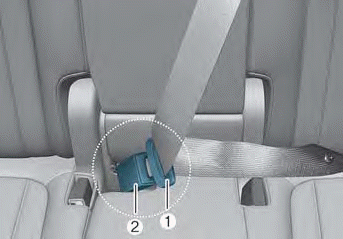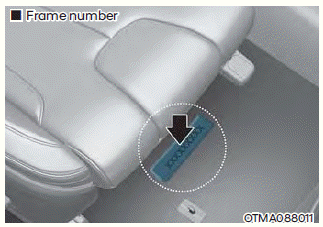Hyundai Santa Fe: Seat belt restraint system / Second row center seatbelt (3-point rear center seat belt)

1. Insert the tongue plate (1) into the buckle (2) until an audible “click" is heard, indicating the latch is locked. Make sure the belt is not twisted.
When using the rear center seat belt, the buckle with the “CENTER” mark must be used.
Information
If you are not able to pull out the safety belt from the retractor, firmly pull the belt out and release it. After release, you will be able to pull the belt out smoothly.
WARNING
Make sure that the seatback is locked in place when using the rear center seat belt.
If not, the seatback may move when there is a sudden stop or collision, which could result in serious injury.
 Rear Seat Belt – Passenger’s 3point system with convertible locking retractor
Rear Seat Belt – Passenger’s 3point system with convertible locking retractor
This type of seat belt combines the features of both an emergency locking retractor
seat belt and an automatic locking retractor seat belt. Convertible retractor type
seat belts are installed in the rear seat positions to help accommodate the installation
of child restraint systems...
 Stowing the rear seat belt
Stowing the rear seat belt
The rear seat belt buckles can be stowed in the pocket between the
rear seatback and cushion when not in use.
Routing the seat belt webbing through the rear seat belt guides will
help keep the belts from being trapped behind or under the seats...
Other information:
Hyundai Santa Fe (TM) 2019-2025 Owner's Manual: System malfunction and limitations
System malfunction When Highway Driving Assist or Highway Lane Change function is not working properly, the ‘Check Highway Driving Assist (HDA) system’ (or 'Check HDA (Motorway Driving Assist) system') warning message will appear, and the warning light will illuminate on the cluster...
Hyundai Santa Fe (TM) 2019-2025 Service Manual: Troubleshooting
Failure Diagnosis 1. In principle, ESP and TCS controls are prohibited in case of ABS failure. 2. When ESP or TCS fails, only the failed system control is prohibited. 3...
Categories
- Manuals Home
- 4th Generation Santa Fe Owners Manual
- 4th Generation Santa Fe Service Manual
- Instrument panel overview
- System settings
- Troubleshooting
- New on site
- Most important about car
Vehicle Identification Number (VIN). Vehicle certification label. Tire specification and pressure label
Vehicle Identification Number (VIN)

The vehicle identification number (VIN) is the number used in registering your vehicle and in all legal matters pertaining to its ownership, etc.
The number is punched on the floor under the passenger seat. To check the number, open the cover.
